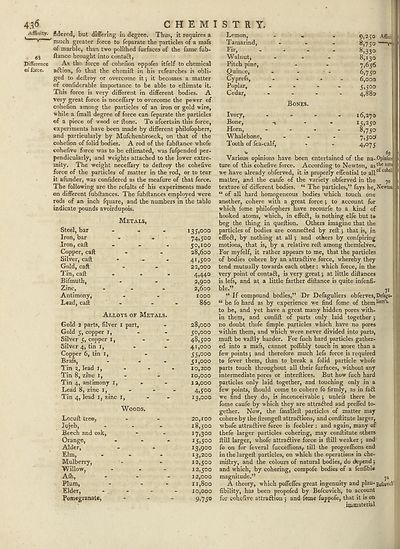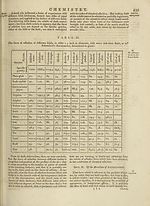Encyclopaedia Britannica, or, a Dictionary of arts, sciences, and miscellaneous literature : enlarged and improved. Illustrated with nearly six hundred engravings > Volume 5, BUR-CHI
(464) Page 436
Download files
Complete book:
Individual page:
Thumbnail gallery: Grid view | List view

43<S
63
Difference
of force.
C H E M I
Affinity, fidered, but differing in degree. Thus, it requires a
' v much greater force to feparate the particles of a mafs
of marble, than two polifhed furfaccs of the fame fub-
ftance brought into contact,
As the force of cohefion oppofes itfelf to chemical
afhon, fo that the chemiit in his refearches is obli¬
ged to deftroy or overcome it j it becomes a matter
of conliderable importance to be able to eftimate it.
This force is very different in different bodies. A
very great force is neceffary to overcome the power of
cohefion among the particles of an iron or gold wire,
while a fmall degree of force can feparate the particles
of a piece of wood or ftone. To afcertain this force,
experiments have been made by different philofophers,
and particularly by Mufchenbroeck, on that of the
cohefion of folid bodies. A rod of the fabftance whofe
cohefive force was to be eftimated, was fufpended per¬
pendicularly, and weights attached to the lowrer extre¬
mity. The weight neceffary to deftroy the cohefive
force of the particles of matter in the rod, or to tear
it afunder, was confidered as the meafure of that force.
The following are the refults of his experiments made
on different fubftances. The fubftances employed were
rods of an inch fquare, and the numbers in the table
indicate pounds avoirdupois.
S T R Y,
Steel, bar
Iron, bar
Iron, caft
Copper, caft
Silver, caft
Gold, caft
Tin, caft:
Bifmuth,
Zinc,
Antimony,
Lead, caft
Metals,
135,000
74»500
50,100
28,600
41,500
22,000
4,440
2,900
2,600
1000
860
Alloys of Metals.
Gold 2 parts, filver I part.
Gold 5, copper 1,
Silver 5, copper I,
Silver 4, tin 1,
Copper 6, tin 1,
Brafs,
Tin 3, lead I,
Tin 8, zinc 1,
Tin 4, antimony I,
Lead 8, zinc I,
Tin 4, lead 1, zinc I,
28,000
50,000
48,500
41,000
J5>00°
51,000
10,200
10,000
13,000
4,500
13,000
Woods.
Locuft tree,
Jujeb,
Beech and oak,
Orange,
Alder,
Elm,
Mulberry,
Willow,
Alh,
Plum,
Elder,
Pomegranate,
Lemon,
Tamarind,
Fir,
Walnut,
Pitch pine,
Quince,
Cyprefs,
Poplar,
Cedar,
9,2^0 Affim:
8.750
8,33o
8,130
7,656
6.750
6,000
5,500
4,880
Bones.
Ivory,
Bone, -»
Horn,
Whalebone,
Tooth of fea-calf,
16,270
I5,250
8,750
7,500
4,075
69
20,100
18.500
17,300
iJ,5°o
13,900
13,200
12.500
12,500
12,000
11,800
10,000
9,75®
Various opinions have been entertained of the na-Opinion,
ture of this cohefive force. According to Newton, as1*16111151
we have already obferved, it is properly effential to all co*ie:;
matter, and the caufe of the variety obferved in the 70
texture of different bodies. “ The particles,” fays he, Newton,
“ of all hard homogeneous bodies which touch one
another, cohere with a great force ; to account for
which fome philofophers have recourfe to a kind of
hooked atoms, which, in effeft, is nothing elfe but t»
beg the thing in queftion. Others imagine that the
particles of bodies are connefted by reft j that is, in
effect, by nothing at all } and others by confpiring
motions, that is, by a relative reft among themlelves.
For myfelf, it rather appears to me, that the particles
of bodies cohere by an attractive force, whereby they
tend mutually towards each other : which force, in the
very point of contact, is very great j at little diftances
is lefs, and at a little farther diftance is quite infenfi-
ble.” 1, . 7i
“ If compound bodies,” Dr Defaguliers obferves, Defagu.
“ be fo hard as by experience we find fome of them h*15’5*
to be, and yet have a great many hidden pores with¬
in them, and confift of parts only laid together $
no doubt thofe fimple particles which have no pores
within them, and which were never divided into parts,
mull be vaftly harder. For fuch hard particles gather¬
ed into a mafs, cannot poflibly touch in more than a
few points j and therefore much lefs force is required
to fever them, than to break a folid particle whofe
parts touch throughout all their furfaces, without any
intermediate pores or interftices. But how fuch hard
particles only laid together, and touching only in a
few points, Ihould come to cohere fo firmly, as in fad
we find they do, is inconceivable $ unlefs there be
fome caufe by which they are attrafted aad preffed to¬
gether. Now, the fmalleft particles of matter may
cohere by the ftrongeft attraftions, and conftitute larger,
whofe attractive force is feebler : and again, many of
thefe larger particles cohering, may conftitute others
ftill larger, whofe attractive force is ftill weaker j and
fo on for feveral fucceflions,' till the progreflions end
in the largeft particles, on which the operations in che-
miftry, and the colours of natural bodies, do depend j
and which, by cohering, compofe bodies of a fenfible
magnitude.” 7 a
A theory, which poffeffes great ingenuity and plau- gj^ich'
fibility, has been propofed by Bofcovich, to account
for cohefive attraction 5 and feme fuppofe, that it is on
immaterial
63
Difference
of force.
C H E M I
Affinity, fidered, but differing in degree. Thus, it requires a
' v much greater force to feparate the particles of a mafs
of marble, than two polifhed furfaccs of the fame fub-
ftance brought into contact,
As the force of cohefion oppofes itfelf to chemical
afhon, fo that the chemiit in his refearches is obli¬
ged to deftroy or overcome it j it becomes a matter
of conliderable importance to be able to eftimate it.
This force is very different in different bodies. A
very great force is neceffary to overcome the power of
cohefion among the particles of an iron or gold wire,
while a fmall degree of force can feparate the particles
of a piece of wood or ftone. To afcertain this force,
experiments have been made by different philofophers,
and particularly by Mufchenbroeck, on that of the
cohefion of folid bodies. A rod of the fabftance whofe
cohefive force was to be eftimated, was fufpended per¬
pendicularly, and weights attached to the lowrer extre¬
mity. The weight neceffary to deftroy the cohefive
force of the particles of matter in the rod, or to tear
it afunder, was confidered as the meafure of that force.
The following are the refults of his experiments made
on different fubftances. The fubftances employed were
rods of an inch fquare, and the numbers in the table
indicate pounds avoirdupois.
S T R Y,
Steel, bar
Iron, bar
Iron, caft
Copper, caft
Silver, caft
Gold, caft
Tin, caft:
Bifmuth,
Zinc,
Antimony,
Lead, caft
Metals,
135,000
74»500
50,100
28,600
41,500
22,000
4,440
2,900
2,600
1000
860
Alloys of Metals.
Gold 2 parts, filver I part.
Gold 5, copper 1,
Silver 5, copper I,
Silver 4, tin 1,
Copper 6, tin 1,
Brafs,
Tin 3, lead I,
Tin 8, zinc 1,
Tin 4, antimony I,
Lead 8, zinc I,
Tin 4, lead 1, zinc I,
28,000
50,000
48,500
41,000
J5>00°
51,000
10,200
10,000
13,000
4,500
13,000
Woods.
Locuft tree,
Jujeb,
Beech and oak,
Orange,
Alder,
Elm,
Mulberry,
Willow,
Alh,
Plum,
Elder,
Pomegranate,
Lemon,
Tamarind,
Fir,
Walnut,
Pitch pine,
Quince,
Cyprefs,
Poplar,
Cedar,
9,2^0 Affim:
8.750
8,33o
8,130
7,656
6.750
6,000
5,500
4,880
Bones.
Ivory,
Bone, -»
Horn,
Whalebone,
Tooth of fea-calf,
16,270
I5,250
8,750
7,500
4,075
69
20,100
18.500
17,300
iJ,5°o
13,900
13,200
12.500
12,500
12,000
11,800
10,000
9,75®
Various opinions have been entertained of the na-Opinion,
ture of this cohefive force. According to Newton, as1*16111151
we have already obferved, it is properly effential to all co*ie:;
matter, and the caufe of the variety obferved in the 70
texture of different bodies. “ The particles,” fays he, Newton,
“ of all hard homogeneous bodies which touch one
another, cohere with a great force ; to account for
which fome philofophers have recourfe to a kind of
hooked atoms, which, in effeft, is nothing elfe but t»
beg the thing in queftion. Others imagine that the
particles of bodies are connefted by reft j that is, in
effect, by nothing at all } and others by confpiring
motions, that is, by a relative reft among themlelves.
For myfelf, it rather appears to me, that the particles
of bodies cohere by an attractive force, whereby they
tend mutually towards each other : which force, in the
very point of contact, is very great j at little diftances
is lefs, and at a little farther diftance is quite infenfi-
ble.” 1, . 7i
“ If compound bodies,” Dr Defaguliers obferves, Defagu.
“ be fo hard as by experience we find fome of them h*15’5*
to be, and yet have a great many hidden pores with¬
in them, and confift of parts only laid together $
no doubt thofe fimple particles which have no pores
within them, and which were never divided into parts,
mull be vaftly harder. For fuch hard particles gather¬
ed into a mafs, cannot poflibly touch in more than a
few points j and therefore much lefs force is required
to fever them, than to break a folid particle whofe
parts touch throughout all their furfaces, without any
intermediate pores or interftices. But how fuch hard
particles only laid together, and touching only in a
few points, Ihould come to cohere fo firmly, as in fad
we find they do, is inconceivable $ unlefs there be
fome caufe by which they are attrafted aad preffed to¬
gether. Now, the fmalleft particles of matter may
cohere by the ftrongeft attraftions, and conftitute larger,
whofe attractive force is feebler : and again, many of
thefe larger particles cohering, may conftitute others
ftill larger, whofe attractive force is ftill weaker j and
fo on for feveral fucceflions,' till the progreflions end
in the largeft particles, on which the operations in che-
miftry, and the colours of natural bodies, do depend j
and which, by cohering, compofe bodies of a fenfible
magnitude.” 7 a
A theory, which poffeffes great ingenuity and plau- gj^ich'
fibility, has been propofed by Bofcovich, to account
for cohefive attraction 5 and feme fuppofe, that it is on
immaterial
Set display mode to:
![]() Universal Viewer |
Universal Viewer | ![]() Mirador |
Large image | Transcription
Mirador |
Large image | Transcription
Images and transcriptions on this page, including medium image downloads, may be used under the Creative Commons Attribution 4.0 International Licence unless otherwise stated. ![]()
| Permanent URL | https://digital.nls.uk/192990301 |
|---|
| Attribution and copyright: |
|
|---|
| Description | Ten editions of 'Encyclopaedia Britannica', issued from 1768-1903, in 231 volumes. Originally issued in 100 weekly parts (3 volumes) between 1768 and 1771 by publishers: Colin Macfarquhar and Andrew Bell (Edinburgh); editor: William Smellie: engraver: Andrew Bell. Expanded editions in the 19th century featured more volumes and contributions from leading experts in their fields. Managed and published in Edinburgh up to the 9th edition (25 volumes, from 1875-1889); the 10th edition (1902-1903) re-issued the 9th edition, with 11 supplementary volumes. |
|---|---|
| Additional NLS resources: |
|

